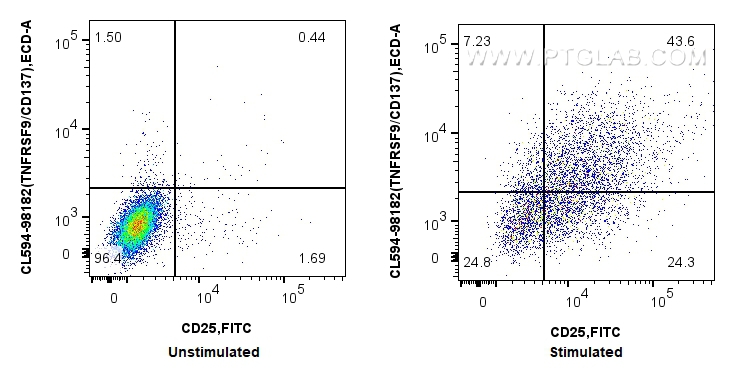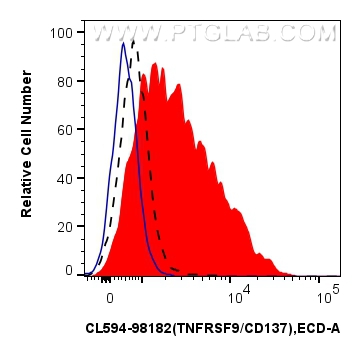验证数据展示
经过测试的应用
| Positive FC detected in | Con A treated mouse splenocytes |
推荐稀释比
| 应用 | 推荐稀释比 |
|---|---|
| Flow Cytometry (FC) | FC : 0.25 ug per 10^6 cells in 100 μl suspension |
| This reagent has been tested for flow cytometric analysis. It is recommended that this reagent should be titrated in each testing system to obtain optimal results. | |
| Sample-dependent, Check data in validation data gallery. | |
产品信息
CL594-98182 targets TNFRSF9/CD137 in FC applications and shows reactivity with mouse samples.
| 经测试应用 | FC Application Description |
| 经测试反应性 | mouse |
| 免疫原 |
Recombinant protein 种属同源性预测 |
| 宿主/亚型 | Rabbit / IgG |
| 抗体类别 | Recombinant |
| 产品类型 | Antibody |
| 全称 | tumor necrosis factor receptor superfamily, member 9 |
| 别名 | 241647E11, 4-1BB, 4-1BB ligand receptor, CD137, Ila |
| 计算分子量 | 28 kDa |
| GenBank蛋白编号 | NM_001077509.1 |
| 基因名称 | Tnfrsf9 |
| Gene ID (NCBI) | 21942 |
| 偶联类型 | CoraLite®594 Fluorescent Dye |
| 最大激发/发射波长 | 588 nm / 604 nm |
| 形式 | Liquid |
| 纯化方式 | Protein A purification |
| UNIPROT ID | P20334 |
| 储存缓冲液 | PBS with 0.09% sodium azide, pH 7.3. |
| 储存条件 | Store at 2-8°C. Avoid exposure to light. Stable for one year after shipment. |
背景介绍
CD137, also known as TNFRSF9 or 4-1BB, is an inducible T cell surface receptor that belongs to the tumor necrosis factor receptor superfamily. CD137 is a transmembrane protein expressed on the surface of activated T-cells. In addition, activation-dependent expression of CD137 has also been found in B lymphocytes, monocytes, and diverse nonlymphoid cell types. CD137 provides a co-stimulatory signal that enhances the survival, and differentiation of cells, and has a crucial role in the development of CD8 cytotoxic T cells and anti-tumor immunity. (PMID: 9826581; 23696891)
实验方案
| Product Specific Protocols | |
|---|---|
| FC protocol for CL594 TNFRSF9/CD137 antibody CL594-98182 | Download protocol |
| Standard Protocols | |
|---|---|
| Click here to view our Standard Protocols |



